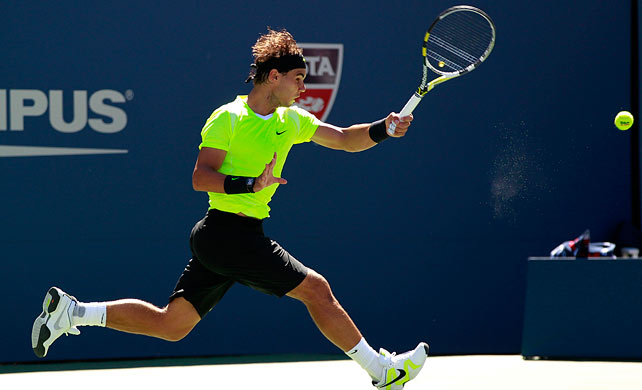Anyone who has seen Rafael Nadal play knows that he possesses two major qualities: he is very strong and he has amazing endurance.
Those two types of fitness have carried him to multiple major titles and enabled him to win almost every match that he has played on clay in the past several years.
The clay courts, especially, separate the fit from the flabby, and Rafa has outworked many an opponent there, staying forceful while his adversaries have wilted.
Factors Behind the Creation of Rafael Nadal’s Training Program
It is worth investigating the key elements of the Rafael Nadal Training routine to see what can be gained by this physical specimen’s personal workout routine. Rafael Nadal’s high level of fitness can be attributed to several factors:
- His heavy playing schedule keeps him in court shape nearly year round;
- He has been blessed with much natural strength. He is from a family of athletes, including some who have reached the professional level and were known for their prodigious strength.
- His workout routine during the weeks when he is not playing matches has left him with a physique and stamina that overpowers many players.


Rafael Nadal’s training routine has actually produced a few tennis shots that no other man on the tour can duplicate, particularly his whip forehand, which often loops far outside the court, only to veer back inside the lines, all at great pace. Rafa crushes this forehand with an angle that produces unstoppable top spin. His arm, core and shoulder strength are keys to the speed on this shot.
The Rafael Nadal Training Program
The keys to Rafael Nadal’s Training are not completely open to public evaluation, but Nadal and his coaches and trainers have been somewhat transparent about the routines that he follows to stay in peak condition. With his recent spate of injuries due to his heavy playing schedule and all-out style of play, it will be interesting to see if there are any changes made to his regimen.
It seems that some change must be made if he is to continue his playing career at the elite level; perhaps he will adopt a lighter load of tournaments on the tour to keep his body fresh.
In short, the Rafael Nadal Training Program consists of extensive strength training during the tennis tour’s preseason and light work during the regular season, with most of his fitness due to his many hours on the court. In the off season, according to some accounts of his routine and a few videos available on the Web, Nadal’s day goes something like this:
- 8:30—wake up, eat breakfast
- 9:30—practice on the tennis courts
- 1:30—practice ends, free time
- 4:30—training in the gymAmong the workout routines in the gym, Rafa starts with a vibrating platform that contracts muscles 30-50 times a second. According to those who sell such machines, they do wonders for blood circulation, muscle strength and flexibility, range of motion and reduced pain and soreness from faster recovery times. Sounds like the base does what steroids do, only it’s legal and doesn’t shrink the testicles! Nadal is living proof, to some degree, of this machine’s effectiveness.
Rafael Nadal Training Exercises
Rafael goes on to alternate between band work and various poses on the vibrating platform in the first half of his workout. Nadal stands flat-footed on the vibrating base at first, and later returns to it to stand on his toes, working the calf and other leg muscles vigorously.
He also sits on a small platform that leaves his feet resting on the vibrating area, holding his hands straight out from his body, which allows the machine to work his legs and core.
Another position that Nadal uses on the platform is holding the front with both hands and standing on just one leg at a time, with the other arched behind him. This heightens the effect on each leg, doubling the intensity of the vibration’s effects.
In another challenging pose, Nadal stands hands free on the platform and balances on one leg, working all sorts of muscles that give stability to the core and fantastic balance on the court, essential for any top player.
Nadal’s Training Consists of Using Elastic Bands
After several minutes on the vibrating base, Nadal begins to work with resistance bands, pulling with one hand both across his body and from front to back. He later grabs two pulleys and pulls front to back on those as well. These bands have been used by many athletes in other sports because they are far more transportable than weights and they allow for variable resistance and a better workout if used correctly.
The bands also work the shoulder and rotator cuff more effectively than free weights, making them popular with sportsmen who engage in contests that tax that joint heavily, such as baseball players, tennis players and volleyball players.


Some would argue that the shoulder and rotator cuff are the most important muscles that a tennis player uses, which is why Rafa spends several minutes pulling on the bands to work that area. In one featured exercise, he takes the band at shoulder height and lifts the handle upwards, forcing his rotator cuff to work hard.
Work with the bands is not the reason why Nadal has bigger biceps, triceps and forearms than most players, he says. He has monitored other players’ routines and says that he does no more than they do to work those areas of the body. His natural physique lends itself to larger muscles in the arm, especially his left arm, which is noticeably larger than his right one. He calls the tennis court his “gym” and says that his frequent mashing of the ball there has given him a left arm to rival Popeye’s.
Rafael Nadal’s Training Consists of a Core Body Workout
Later in his workout, Rafa does core work. Standing anchored to the wall by bands around his knees, he does front bends at the waist, a sort of standing sit-up that will give fire to the belly. Later, he does a variety of push-ups, including a few sets where he grips elevated stands to maximize the dip. He also does a form of pull-up, raising his body slightly and repeatedly for almost one minute, then repeating.


Finally, Nadal does work on the exercise ball, balancing on it for light sit-ups that work multiple muscles in the core as he balances on the ball. The lower back is also worked more strenuously when a ball is used because the back is arched much more than during a traditional sit-up. Nadal also does a form of a plank, resting on his elbows while his feet are elevated and resting on top of the ball. This, too, does wonders for the muscles in his core.
A round of catch with his trainer, using a medicine ball, ends the workout on a light note. Nadal is careful to turn his body completely with each toss of the ball, fortifying the very muscles that he will use later in the week or month as he takes his racquet back and unscrews his body in a powerful motion, launching another rocket from the forehand or backhand side.
Stretching – A Key part of Nadal’s Training
Rafael Nadal’s Training regimen concludes with extensive stretching, which he considers key to his overall fitness and success on the court. Nadal has a personal therapist who stretches him out every day, using different exercises to work different muscles according to the playing surface used at that time.
During tournaments on grass courts, for instance, Nadal works his lower body much more than normal due to the low bounces that result from the skids on grass. He plays much lower to the court during these tournaments and is frequently hunched over.


Rafael Nadal’s Training program probably does not look like what most Americans would predict. There are no free weights clanging around, no inclined benches for challenging sit-ups. The workout is both more high-tech and more low-tech than one might anticipate.
An expensive vibrating platform is used often during the sessions in the gym, yet the rest of the workout can be done by anyone with a few elastic bands, a balance ball, a chin-up bar and a medicine ball. All of these elements combine to produce a body that until recently has seemed indestructible and almost unbeatable.
Learn to Hit a Forehand Like Roger Federer
If you want to jumpstart your forehand and play like the PROS, check out my 70+ page Tennis Ebook that will immediately show you how you can take your forehand to the next level.
The Modern Forehand Domination Ebook is guaranteed to improve your tennis technique, and increase power, topspin and accuracy of your tennis forehand!
Modern Tennis Forehand Ebook
Learn How to Hit a Forehand Like Federer, Nadal and Djokovic

